
Our Heritage
The Mass Observation Archive was founded in 1937 with the aim of creating an ‘anthropology of ourselves’. It uses a unique social history resource to document the everyday lives of ordinary people in Britain before, during and after the Second World War. A panel of hundreds of contributors write about their experiences, observations and perspectives on a variety of subjects and individuals. The Mass Education project aimed to widen participation in the resource. 12 volunteers learned how to interpret the archive material, ranging from survey data to photographs.
120 people in Sussex’s wider community were engaged in the project through visits, outreach sessions and creative workshops. Six community groups and schools participated in a ‘12th May Day Diary’, an annual event to mark the coronation of George VI, where people from all walks of life upload their diary writing to the Mass Observation Communities on-line website.
Six schools took part in workshops and adopted the role of Mass Observers to learn about the everyday lives of young people in the 1930s, 40s and 50s. The key stage two and four students accessed real live historical artefacts housed in a modern archive. They responded creatively to the theme of documenting everyday life by participating in drama and photography.
A public exhibition at the Keep, also available online, was a platform for the schools and community groups to showcase their Mass Observation work. A further exhibition, hosted by a large bi-annual photography festival in Brighton, provided an opportunity for the participants to share their photography with over 6,000 visitors. A diverse audience of local people explored and enjoyed the heritage as a result of the project.